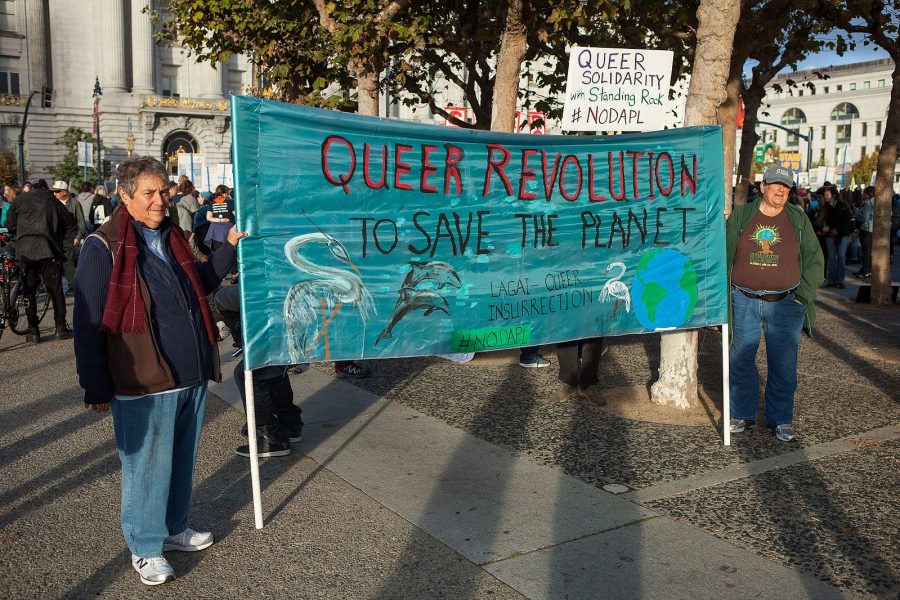Dakota Access Pipeline imperils environment
Wikimedia Commons
Protesters carry a sign promoting the environment at a protest against the Dakota Access Pipeline. The pipeline would allow fracking in the Bakken formation, which would contaminate the water supply there.
January 25, 2017
Protesters against the Dakota Access Pipeline have highlighted environmental concerns with its construction. If completed, the pipeline will stretch from the Bakken shale formation in North Dakota, one of the largest oil deposits in the U.S., through South Dakota, Iowa and Illinois. Approximately 7.4 million barrels of oil lie in the Bakken formation, meaning that the pipeline could carry nearly 374.3 million gallons of gasoline per day if built. With its high value, the pipeline was approved by the U.S. Army Corps of Engineers in July 2014, only to be halted by complaints from the Standing Rock Sioux tribe in July of 2016. Members of the tribe claim that the pipeline would threaten the tribe’s environment and destroy consecrated areas.
One of the tribe’s main concerns revolves around the pipeline’s transferring gallons of oil half a mile away from their water source.
“We are on this Earth, and it is part of our culture to respect planet Earth or Mother Earth as much as possible,” Vice Chairman of Viejas Band of Kumeyaay Indians Victor Woods said. “If we look at American history, we never took from the land any more than we needed, and obviously today we are surrounded by all kinds of attempts to utilize any and all resources that are available. There are billions of dollars to be made in oil or transportation.”
While pipeline advocates argue that pipes are a safer alternative to trucks or rail transport, the tribe says that pipelines still have the potential to cause severe damage. For instance, the 20,600-barrel leak from the Tesoro Logistics LP Pipeline in September 2013, one of the largest spills from a North Dakota pipeline, would have grown larger had a farmer not noticed a hole in the pipeline. No major environmental effects resulted from the leak; however, the precedent of such pipeline bursts concern members of the Standing Rock Sioux Tribe.
The Dakota Access Pipeline is projected to pass under the Missouri River according to the proposed plan, meaning that a pipe rupture could cause severe damage to the surrounding environment.
“When looking at the route of the pipeline, there is no consideration for what unknown cultural sites are located adjacent to, underneath, above or in the pipeline,” Woods said. “I think these are very important to any Native American community here in the Continental U.S. or anywhere in the North American region.”
The Pipeline and Hazardous Materials Safety Administration states that more than 3,300 occurrences of leaks and ruptures of U.S. oil and gas pipelines since 2010. Previous oil spills such as the Kalamazoo River spill in Michigan have cost over $1 billion to clean up. Any oil pollution in the Missouri River could pose an everlasting contamination issue.
Besides contaminated drinking sources, the tribe also argues that the pipeline increases climate change. Constructing additional oil pipelines perpetuates the use of fossil fuels and increases the area’s carbon footprint tenfold. The tribe advocates for the use of renewable sources of energy instead to avoid disturbing the Standing Rock land. Protesters continue to advocate against the pipeline’s construction due to the threats they say it poses for the environment.


















![“[Building nerf blasters] became this outlet of creativity for me that hasn't been matched by anything else. The process [of] making a build complete to your desire is such a painstakingly difficult process, but I've had to learn from [the skills needed from] soldering to proper painting. There's so many different options for everything, if you think about it, it exists. The best part is [that] if it doesn't exist, you can build it yourself," Ishaan Parate said.](https://harkeraquila.com/wp-content/uploads/2022/08/DSC_8149-900x604.jpg)




![“When I came into high school, I was ready to be a follower. But DECA was a game changer for me. It helped me overcome my fear of public speaking, and it's played such a major role in who I've become today. To be able to successfully lead a chapter of 150 students, an officer team and be one of the upperclassmen I once really admired is something I'm [really] proud of,” Anvitha Tummala ('21) said.](https://harkeraquila.com/wp-content/uploads/2021/07/Screen-Shot-2021-07-25-at-9.50.05-AM-900x594.png)







![“I think getting up in the morning and having a sense of purpose [is exciting]. I think without a certain amount of drive, life is kind of obsolete and mundane, and I think having that every single day is what makes each day unique and kind of makes life exciting,” Neymika Jain (12) said.](https://harkeraquila.com/wp-content/uploads/2017/06/Screen-Shot-2017-06-03-at-4.54.16-PM.png)








![“My slogan is ‘slow feet, don’t eat, and I’m hungry.’ You need to run fast to get where you are–you aren't going to get those championships if you aren't fast,” Angel Cervantes (12) said. “I want to do well in school on my tests and in track and win championships for my team. I live by that, [and] I can do that anywhere: in the classroom or on the field.”](https://harkeraquila.com/wp-content/uploads/2018/06/DSC5146-900x601.jpg)
![“[Volleyball has] taught me how to fall correctly, and another thing it taught is that you don’t have to be the best at something to be good at it. If you just hit the ball in a smart way, then it still scores points and you’re good at it. You could be a background player and still make a much bigger impact on the team than you would think,” Anya Gert (’20) said.](https://harkeraquila.com/wp-content/uploads/2020/06/AnnaGert_JinTuan_HoHPhotoEdited-600x900.jpeg)

![“I'm not nearly there yet, but [my confidence has] definitely been getting better since I was pretty shy and timid coming into Harker my freshman year. I know that there's a lot of people that are really confident in what they do, and I really admire them. Everyone's so driven and that has really pushed me to kind of try to find my own place in high school and be more confident,” Alyssa Huang (’20) said.](https://harkeraquila.com/wp-content/uploads/2020/06/AlyssaHuang_EmilyChen_HoHPhoto-900x749.jpeg)







